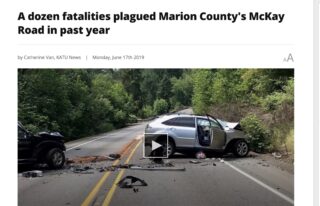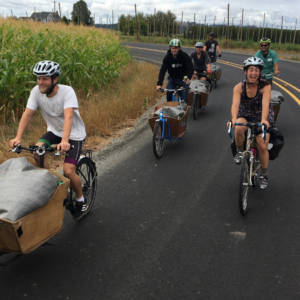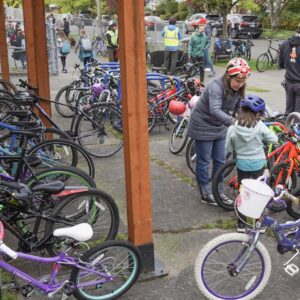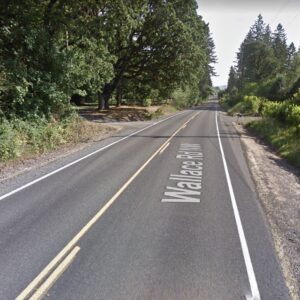
A bill that has received unanimous support from the Oregon House and Senate will give counties throughout Oregon a new tool to improve safety on rural roads.
House Bill 3213 creates a pilot program that will allow five counties to designate a dangerous stretch of road as a “safety corridor”. The legislation is meant to stem the tide of serious and fatal crashes that plague rural roads throughout the state. During committee hearings for the bill, lawmakers heard that many of Oregon’s once quiet farming roads now see increased levels of driving due to population growth and people who want to avoid congested interstates.
Some of these rural, county-owned roads also happen to be popular for bicycle riding.
“While Oregon backroads are some of the most beautiful drives in Oregon, they can be some of the most dangerous.”
— Shelly Boshart Davis, state rep who sponsored the bill
The first I heard of this bill came in a story published yesterday by KATU about McKay Road, south of Champoeg State Park in the Willamette Valley. The headline, “A dozen fatalities plagued Marion County’s McKay Road in past year,” caught my eye. I’ve ridden on McKay Road and it crosses the Willamette Valley Scenic Bikeway route.
Dennis and Sylvia Melcher are farmers who’ve lived in St. Paul near McKay Road for 60 years. “We have witnessed this road being transformed from a country road to a major highway thoroughfare,” they wrote in committee testimony, “Drivers are traveling on this road at 70 MPH or faster!”
Advertisement
The bill’s chief sponsor was State Representative Shelly Boshart Davis, a Republican who represents the rural farming district around Albany south of Salem. In a letter of support for her bill, Boshart Davis wrote, “While Oregon backroads are some of the most beautiful drives in Oregon, they can be some of the most dangerous… Law enforcement and county governments around the state are looking for ways to make these roads safer… By allowing county governments the power to bring awareness of the dangers of backroad driving, we give them another tool in their toolbox to save lives.”
The county version will be modeled after the existing program already in place at the Oregon Department of Transportation. Once a safety corridor is identified (must be 2 to 10 miles long and have a documented history of serious and fatal crashes), the transportation department can install caution signage and fines for traffic violations are doubled.
The bill also calls for the establishment of an advisory committee made of up county representatives. While this new program would be modeled after ODOT’s existing program, it’s likely to give county governments more flexibility to address safety concerns.
I asked a Multnomah County if they were aware of the bill and/or if they had any plans to take part in the program. Spokesman Mike Pullen said they haven’t identified any safety corridors as of yet, but they recognize it could be another tool to address safety.
This is an interesting development. I’ve personally been dreaming of a “bicycle safety corridor” designation for a few years now that would be modeled on the same program. Along with increased fines and caution signage, I’d like the designation to come with things like a “move over” passing law when a bicycle rider is present, implementation of bicycle turnouts, a speed limit reduction, and so on. Perhaps next session!
Learn more about HB 3213 here.
— Jonathan Maus: (503) 706-8804, @jonathan_maus on Twitter and jonathan@bikeportland.org
Never miss a story. Sign-up for the daily BP Headlines email.
BikePortland needs your support.





Thanks for reading.
BikePortland has served this community with independent community journalism since 2005. We rely on subscriptions from readers like you to survive. Your financial support is vital in keeping this valuable resource alive and well.
Please subscribe today to strengthen and expand our work.
Interesting.
Kind of has an expensive, end-of-pipe feel to it, this solution.
Isn’t it all about speed? Don’t we already know that raising the speed limits, allowing generous buffers on top of the posted limits, as we have historically done, are terrible ideas?
I can see it now: more dreaded center stripe rumble strips that motorists will be reluctant to cross over so they will choose to close-pass people on bikes. We’re going to be faced with the choice of riding on the shoulders and being buzzed or eschewing them and taking the lane. This is going to reduce cycling numbers. Add in a few shoulder rumble strips and it’s made to order to get rid of those pesky people on bikes. Why does everything that is done in the name of safety end up making life worse for anyone not in a deadly conveyance?
It probably won’t even do much to reduce crash rates. Motorists will use the rumble strips as a warning, like bumpers, to look up from their vibrating toys, but will continue to drive too fast and distracted so they will continue to smash into things.
McKay Road shows what happens when more nearby freeways get built: Newberg Dundee bypass which has already had a fatal crash.
Putting up a sign that says “safety corridor” won’t cut it without enforcement. And, I don’t understand why enforcement is such a no-no with everyone. It’s inexpensive to do and can be very profitable for police departments. Jordan Valley, Oregon, used to support its entire city budget, small that it is, by strictly enforcing its speed limit through town.
Want to save lives? Lower speed limits. Fines high enough to be significant financial hardships to almost any driver. Car seizures, phone crunching, and absolutely merciless enforcement. Get over it, folks–the United States Constitution doesn’t contain the word “automobile” anywhere, not even once.
day fines.
This is entirely useless. NM and AZ have many of these zones. Never see a cop enforcing them, traffic always going well over the speed limit with outliers even faster. As a cyclist, I wouldn’t trust riding though one of these “safety zones” any more than any other stretch of road.
When I was younger and (much) dumber, I was pulled over in a safety corridor while excessively speeding. My un-reducible $700 speeding ticket completely changed the way I drive forever. That said, it isn’t often that I see police enforcing those areas, and I have a feeling a lot of people who see those signs don’t even know what it means.
I had to look up the definition online when I first moved to Oregon 10+ years ago when I first saw one of the signs (I think it was on Hwy 26 driving to Mt Hood). Until I did that I had no idea what it could mean. Safety Corridor doesn’t really make sense…they should be termed High Crash Corridor or something more descriptive.
maybe : “High Fine Area”?
DEATH ZONE AHEAD
The only meaningful way to make these roads safer? Remove center lane lines and make it a one lane road with a 30mph speed limit. The rest of the road can be wide shoulders with rumble strips that drivers only cross when negotiating oncoming traffic. More features to band aid and coddle dangerous driving won’t help.
Also, change it to gravel.
Sorry, what is the tool? A committee?
Let’s get the bicycle stop as yield law passed, then install stop signs on these roads every mile, at, let’s call them “wildlife corridor crossings”. The fine for running a stop sign is $265, double that for it also being a safety zone, enforce them weekly and behavior will change very quick and because of the bike law, we can just slowly roll through all of them.
We (in Washington State) have the safety corridor tool…and we used it along several of our old outdated urban arterials to add enforcement and multimodal enhancements. So good luck with this new tool and make the most of it. (Perhaps tie it to the Oregon Bike Tourism priorities for more money and political exposure.)
Additionally, the County (?) should work with TomTom/ Google / Waze to “de-emphasize” this as a commuter thru route. (And add a danger weighting / index.)
Thanks for covering safety initiatives on rural roads. It seems some commenters can never be satisfied with incremental and feasible improvements. While some wait for conversion to one lane or gravel, car seizures for violators, better enforcement, etc., I’ll gain comfort by believing that at least some drivers respond appropriately in safety corridors. As the post says, it’s a tool, not a panacea, and bill seems better than nothing to me. Kudos to a Republican in a rural district for sponsoring it.
Did this bill pass ?